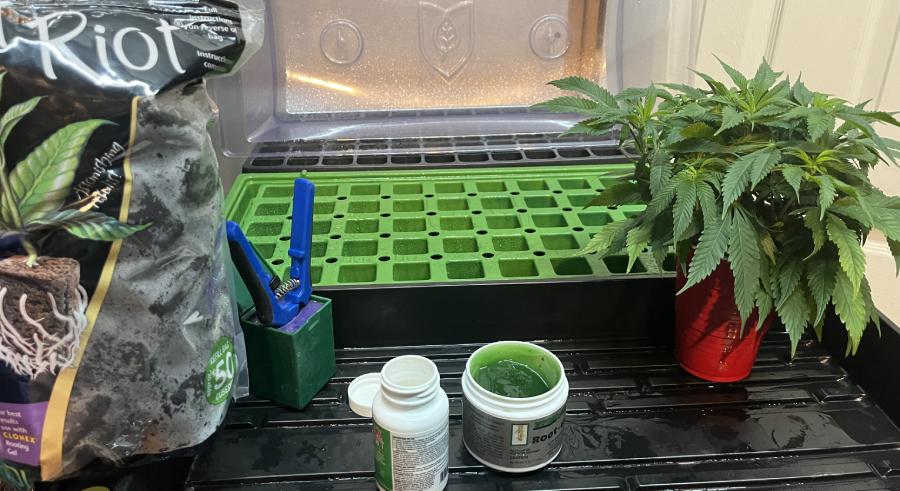Having trouble with marijuana cloning? Need a fool-proof way to get clones of your favorite mother plant more consistently? Look no further, this guide is going to get you the clones you need each and every time.
What is a cannabis clone? What are the advantages of taking marijuana clones? Well, first of all, cloning is one of the easiest and fastest ways for cannabis growers to make many new plants (that cost pennies) at once!
Cloning cannabis involves making a small copy of a specific cannabis plant. A clone is a piece of plant that has been cut off (a “cutting”) from a parent plant and then allowed to grow roots.
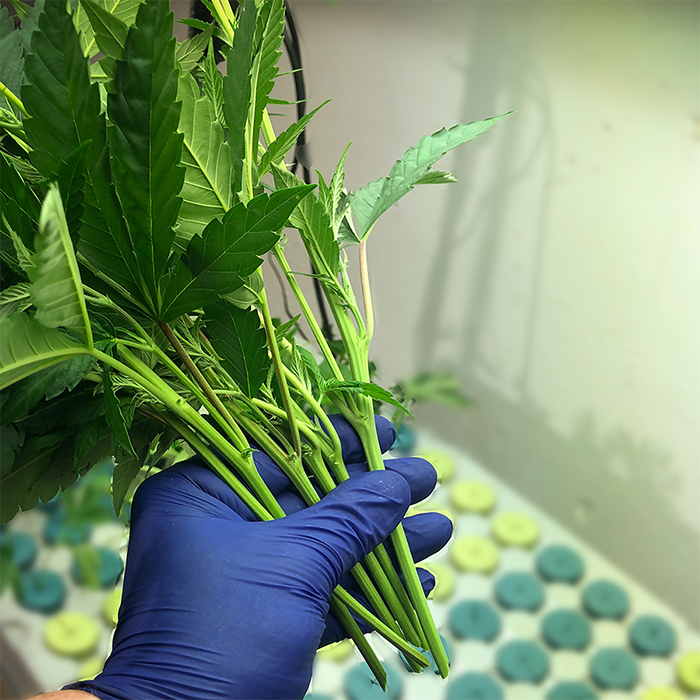
Cannabis clones are cuttings from a marijuana plant – they make their roots and grow into an identical plant as the “mother”! Each cannabis clone has the same genes and is a genetic copy of its parent. So, if the clone’s parent is a female, you are guaranteed that all the clones taken from that cannabis plant will be female, too.
Cannabis growers care about plant gender because, depending on the strain of cannabis, some cannabinoids (chemical compounds that produce the high associated with cannabis use) are produced only in males, while others are produced in both males and females. If you’re growing cannabis for recreational use, you want to make sure you’re getting cannabinoids that are of the type that you want to consume.
So, by growing cannabis clones from mother plants of different genders, you can ensure that you’re getting the right kind of cannabis.
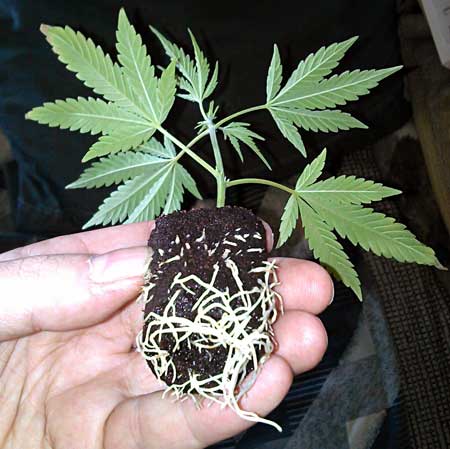
Cloning cannabis lets, you make dozens of (practically free) identical cannabis plants quickly! Save your favorite plants to grow again!
READ: The Best Aero Cloner Cannabis Cloning Technique
Marijuana growers can take many clones of a single marijuana plant. This is an easy way to get many plants that will grow in the same way as the mother plant and produce buds with similar characteristics (aroma, flavor, THC content, CBD content, CBN content, etc.)
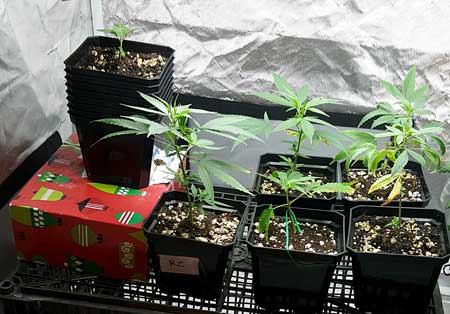
Why Clones? The value and beauty of Growing Cannabis Clones
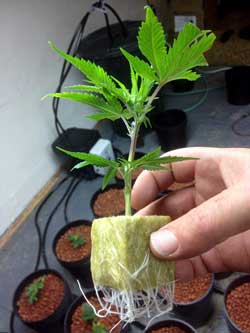
Taking cuttings and cloning can be a great way to propagate a cannabis strain or a particularly nice cannabis plant, without having to worry about male plants or making or buying seeds. Each clone costs only pennies!
There is debate about the best way to clone cannabis plants. There are many effective techniques, and this tutorial will teach you how to clone today. However, cloning should only be used with the healthiest, most desirable plants you have. Although technically, you can clone any plant at almost any point in its life, you want to clone your best plants, which have proven to be successful.
There is some debate about the best way to clone cannabis plants. There are many effective techniques, and this tutorial will teach you how to clone today. However, cloning should only be used with the healthiest, most desirable plants you have. Although technically, you can clone any plant at almost any point in its life, you want to clone your best plants, which have proven to be successful.
Today I will walk you through the entire process of cloning marijuana and clear up some myths and misinformation.
I don’t want to make clones; where can I find seeds?
How Cloning Marijuana Works
At its simplest, cloning means cutting off a piece of plant and sticking it in the ground! New roots grow out of the stem, and soon you have a new cannabis plant!
If you study cannabis clones, you can see the roots grow directly out of the stem.
Supplies to Clone your Cannabis Plants
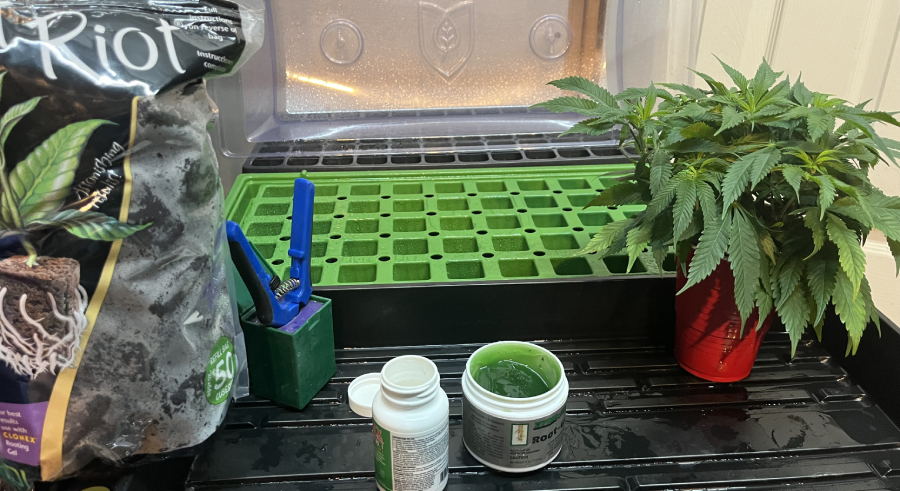
- “Mother” cannabis plant to get your clones from
- Sharp scissors or razor
- Starter cubes/plugs
- Clone grow light
- Tray and Humidity Dome
- Cloning Gel or Rooting Powder (optional but recommended)
- Seedling heatmat (optional)
Last update on 2025-04-11 / Affiliate links / Images from Amazon Product Advertising API
Video: Cannabis Cloning Process
How to Take a Cannabis Clone
Learn and understand how to take a clone from your cannabis mother plant. Before anything, clean and disinfect all your tools, and prepare everything, including setting out all your supplies.
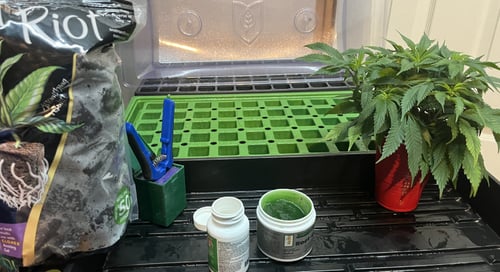
Total Time Needed :
30
Minutes
Total Cost:
20
USD
Required Tools:
Things Needed?
Steps to cloning marijuana:

To clone cannabis plants, take cuttings from plants with alternating leaves – if the leaves are connected at the same point on the stem, the plant is not ready to be cloned. An example of a marijuana stem with alternating leaves on a plant that is perfect for cloning is shown below.
Soak starter cubes/plugs in 3/4 strength Bloom Nutrient solution (optional – can use plain water)for a couple of minutes in water. Do not leave them water logged.

Choose a spot where there is new branching and a new top, and cut a little bit below that.
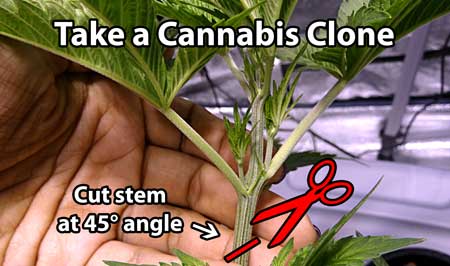
Just firmly grab the new growth and cut the branch away at a 45-degree angle. New cuttings should be 5-8 inches (10-20 cm) long. Immediately put your new marijuana cutting in a glass of water! This will help prevent bubbles from getting in the stem!
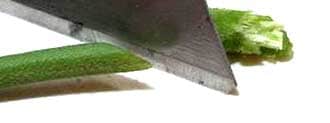
Trim off any huge lower leaves or node points from the new cutting and clip the top fan leaves if they’re big. Clipping the leaves helps prevent the weed clone from “over-exerting” itself and trying to turn light into food when the plant should be focused on roots. Once leaves are trimmed, make one final 45-degree cut on the stem to expose fresh tissue.
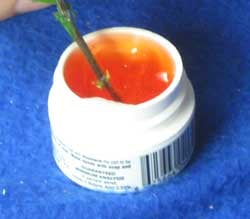
You can take cannabis clones using plain water, and your cuttings will make roots sitting in the water. Some growers use rooting hormones and other cloning products to help the plant root faster.
To Dip or Not to Dip: Some growers will use rooting hormone powder or gel to seal off air bubbles on newly-scraped cuttings, and then give the cutting what it needs to start making roots.
Make sure to coat the bottom of the cutting with gel before inserting it into the starter cube. Place the new clone into a moistened starter cube, and press around the bottom to ensure that it is sealed and no air can get to the rooting area.

Place the cubes into the tray ensuring not too much of the leave are touching to prevent places for moisture to hide in the dark. Place the Humidity dome onto the tray and place under your light.
How to Care for New Clones
Clones like warm, wet conditions.
Think springtime.
Your clones need to get their water through their leaves because their roots haven’t formed.
That’s why a nice humid cloner works excellently, or you can mist your plants a few times a day until they start forming roots.
Some growers use a heating pad under their clones to help keep things warm.
A little warmer than room temperature, 72-77 °F (22-25 °C ) is perfect. Many automatic cloners come with a heat setting.
Some growers don’t use any grow lights for the first 1-2 days while clones get settled. Other growers do give light right from the beginning. It’s common to leave new clones in a warm, bright area for the first day or two, for example, with a weak grow light like a CFL bulb.
Leave your grow lights on an 18/6 (Light/Dark) for your new clones. Don’t give new clones 24 hours of light without any dark periods. This can slow down the rooting process. Rooting seems to happen best when there’s some amount of darkness each day.
The most important thing is to keep a close eye on your new clones until they’ve become well-established
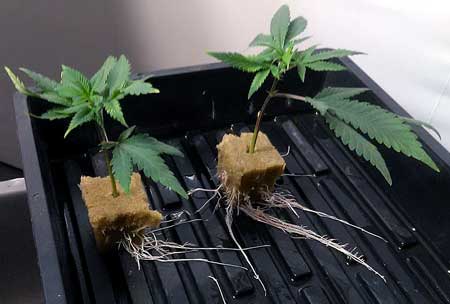
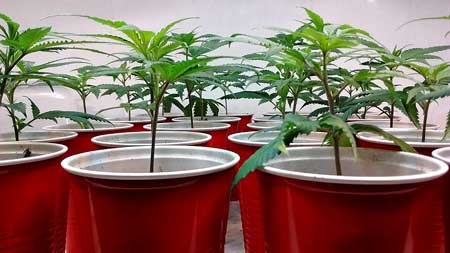
Cannabis Cloning Grow Lights
When getting clones started, you should only use low-intensity light on your new clones for the first 10 days.
Clones want light from the beginning, but focusing on making roots, they don’t want a lot since they aren’t as strong as rooted plants!
For clones, a cheap CFL or other fluorescent grow light is a great option. These lights are not too intense, and can be kept about 8-9″ above your plants. Not to mention you can find them at every hardware store for a reasonable price.
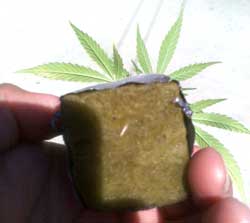
If you already haveHID grow lights like Metal Halide and High-Pressure Sodium bulbs, these will work too, but becareful. HID lamps need to be kept 2-3+ feet away from new clones so they don’t get too hot and burn and stressed.
If you start with intense lights, treat your cuttings like seedlings until your clones have formed strong roots. For example, a 400W HPS grow light is good about 30 inches away from the top of your clones while they’re rooting.
If you are using HID lamps, keep the lamp height the same as if you would for seedlings until they have strong roots. For example, a 400 watt HPS grow light should be placed about 30 inches away from the top of the clones when they are rooting
If you’re growing in Rockwool cubes or other starter cubes like Rapid Rooters, then you know your clones are ready to be transplanted and receive regular light when you see the roots coming out the bottom of the cubes.
Remember, new clones are weak and should be treated gently like seedlings until they start thriving. But within just a week or so, you will have fast-growing plants that are much bigger than any week-old seedling!
And remember to be patient if it’s your first time. Almost every cutting will take root if you wait long enough and keep providing the right conditions. Some plants will root in just a few days, 7 days is average, but some clones can take 2 weeks (or even more) to start showing roots!
Cannabis Cloning Tips
1) Keep the leaves of each new clone gently moist – clones love misty conditions (especially the first week after taking a cutting)
This is why many growers buy cloners, or a tray with a humidity dome (a clear plastic top to put over their plants), since they will keep your cuttings nice and moist for you and practically automate the whole process. However, with a humidity dome, it’s essential to keep an eye out for mold.
If you don’t have a humidity dome (or even if you do), it can be a good idea to mist each clone with water after you’re done to keep them moist. If you can mist your clones a couple of times a day, so they don’t dry out, you may be able to skip the clear top altogether. Another option is to put the clear top over your plants while you’re away from your grow area(like when you’re at work), then take it off while you’re around to check on your clones and mist them regularly with water.
Most domes have vents to let them expel extra air, and you will want to open them if it starts looking too misty in there!
2) Give each clone a little something extra to help make roots
In addition to cloning gel or powder, some growers recommend spraying the leaves with a very mild nutrient solution, as the clones can absorb a tiny bit of nutrients through their leaves.
Some growers may also add a small amount of…
Hormex Rooting Hormone Concentrate with B1 – Root Growth Stimulator for Stronger, Thriving Plants – Prevents Transplant Shock – Hydroponics, Houseplants, Gardens, Trees, Fruits and Vegetables – 4ozPotassium silicate protectant (Dyna-Gro Pro-TeKt is a great source that has been time-tested for cloning marijuana)
To promote root growth, try to give new clones a minimum nitrogen level and possibly increased phosphorus levels. Any sort of flowering nutrients would be well suited to give to new clones. However, ensure that if you’re feeding them nutes, give them only 1/4 to 1/2 the recommended amounts for seedlings!
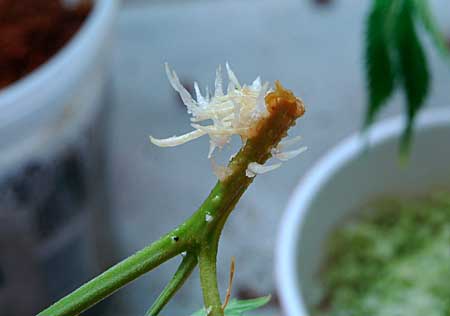
3) Use rooting powder or gel (that has been properly stored)
Creating clones of plants can be a daunting task, but using cloning solutions or powders is a popular, easy way to help the cloning process. Rootech Cloning Gel is a great choice that can be applied easily and evenly to the plant, while powders can also be used if desired. Both can be purchased from a grow shop, garden store, or online. Additionally, these cloning products typically contain hormones to help the cloned root, which can be beneficial in the cloning process. If you’re looking for an easy and reliable way to clone your plants, Rootech Cloning Gel and/or cloning powder are great options to consider. Finally, using high-quality cloning products can help ensure that your clone is successful, healthy, and ready to be transplanted.
Store your rooting powder or gel in a cool, dark, dry place, and never use “contaminated” rooting powder or gel.
If the package was unsealed when you got it, or if you’ve dropped anything into the rooting hormone, discard it and get a fresh package. Foreign materials like leaves, dirt, dust, etc., can cause bad stuff to grow in your gel or powder, negatively affecting your cloning results. Some cloning gels come with a handy applicator tip, which makes them easier to use and reduces waste and the chance of contamination.
4) Take cuttings from a well-established and healthy plant
You will get better results if you use clones from a well-established plant (at least two months old). Younger plants may not mature, and their clones can take much longer to root or may not root at all.
If you grow a plant in the vegetative stage for about 2-3 months, you can get dozens of clones off a single plant.
It’s terrific if you take a couple of clones from a plant and then let it grow. It’s best to take the clones off the bottom of the plant since they tend to take root in much less time than clones taken from the top.
5) Take clones off the bottom of the plant for faster rooting and the top of the plant for faster flowering
Getting plants to root as fast as possible is best to take the clones off the bottom since they tend to have more root hormones and take root in less time than clones taken from the top of the plant.
If you want to flower the plant right away to determine the gender, you’ll often have better luck taking a clone from the top of the plant, which tends to be more primed to flowering.
6) Prepare the mother plant for cloning if you can
If possible, give a potential mother less nitrogen than usual when feeding for a week or two before cloning, as this will promote better rooting in her clones. Regular flowering nutrients work well.
7) Take more clones than you need
Save yourself a boatload of frustration by always taking more cuttings than you need. You will lose a few clones initially, but I promise it will get easier.
Some clones take longer to root. I’ve had a clone that didn’t do anything for almost a month (it didn’t wilt or grow), and I was just about to throw it away before it exploded with new growth and became a healthy adult plant. However, it’s usually easier to take many extra marijuana clones and throw away any that take longer than the others to make roots.
8) Don’t forget to label every cannabis clone, or you will regret it!
You might be amazed at how much you can forget in the week it takes for roots to form.
9) A cannabis clone from a flowering plant will grow differently at first; this is normal!
You want to take clones off a cannabis plant when it’s in the vegetative stage if possible because cuttings will root faster, but you can also take clones from a flowering plant if you have a prize plant you want to save. When taking clones from a flowering cannabis plant, choose clones from the bottom and immediately pinch away any buds you see. You can treat new clones the same as any other.
Clones from flowering plants may grow more “bushy” than their parent plant and will often show other strange growing patterns, especially in the first few weeks after being cloned (for example, rounded leaves). It’s completely normal for clones taken during the flowering stage to have weird leaves and growth patterns for the first few weeks.
Marijuana clones taken from a flowering plant will display strange growth for the first few weeks, but leaves will soon start growing normally again.
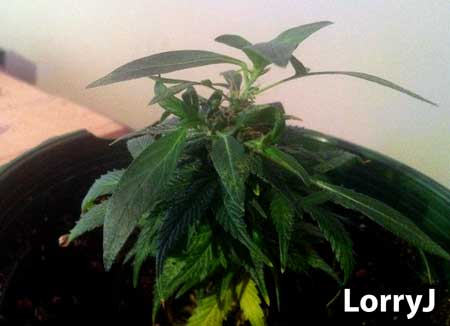
10) Choosing and taking care of “mother” plants
All clones are genetically identical to the plant you took them from. So if you have an incredible plant specimen, you can make more plants with similar characteristics to the mother cannabis plant. You can take dozens of clones from a single plant. Anywhere, a “growth tip” will yield a clone!
Cloning Cannabis: How to Select a “Mother” Plant
As the grower, you’re looking for hardy female plants with fast growth, big roots, huge yields, and potent buds.
It is generally recommended to take clones during the vegetative stage of marijuana because clones taken during the flowering stage can have a much harder time taking root. However, if you take clones from the bottom of a cannabis plant in the flowering stage, you can usually get it to clone by pinching off any buds and following the usual steps. This can be a great way to save a plant performing well in the flowering stage!
Note: Some growers take clones during the flowering stage on purpose, using a Monster Cropping technique. Clones taken during the flowering stage can sometimes display unusual growth patterns and become crazy branching monsters. Depending on the grow setup, this can be taken advantage of.
Ok, so you want to take clones during the vegetative stage if possible, yet how do you choose the best mother plants that will give you the most potent buds and bountiful yields? You don’t know how the plant will turn out since she’s still vegetative.
You could choose to clone any plant, and maybe that’s what you want to do if this is your first time cloning. Yet if you want the best results, you should grow clones from only the best plants.
What’s the best size to make a cannabis clone?
You’re growing weed plants, and about to take clones (which is done by cutting off a branch and forcing it to grow roots), so you get free new cannabis plants. You ask yourself, should my cannabis clones be big or small? What length should I cut the branch to make a perfect size clone?
When making cannabis clones by cutting off a branch, you must decide how long to make the clone. I’ve found the best size length to make a marijuana clone is 7-9″ (18-23 cm) long. This stem is 7″ long. Perfect!
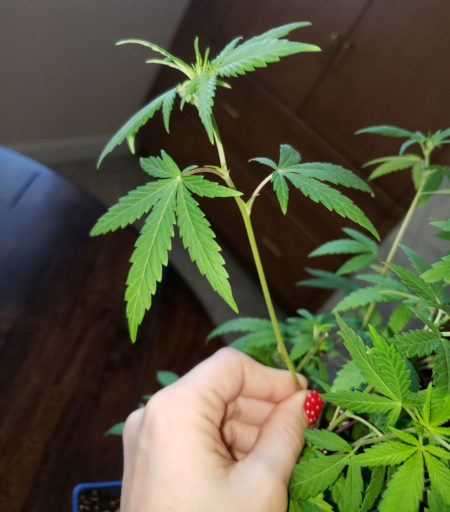
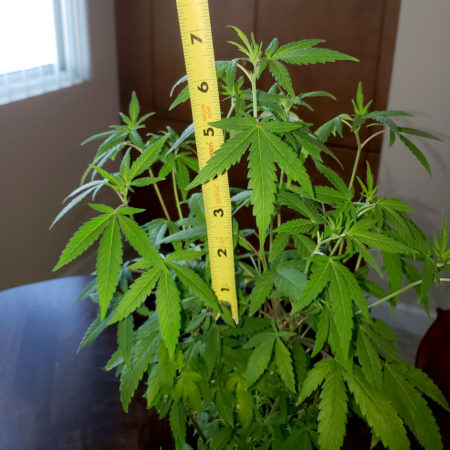
If you don’t have long enough stems, give the mother plant another week or two so that you can make clones the proper size.
Now that you’ve chosen the branch you want to turn into a new clone, how do you turn this stem into a new plant with roots? Here are 3 easy ways to clone:
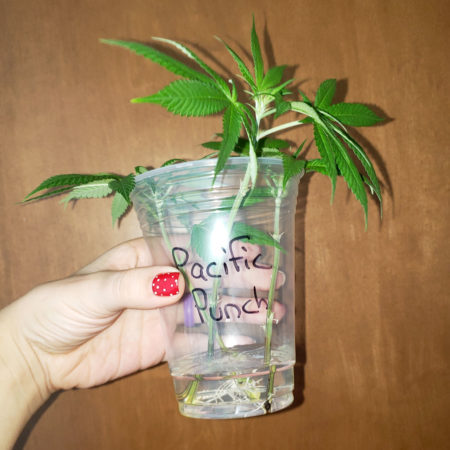
Learn how to clone cannabis in Jiffy pellets
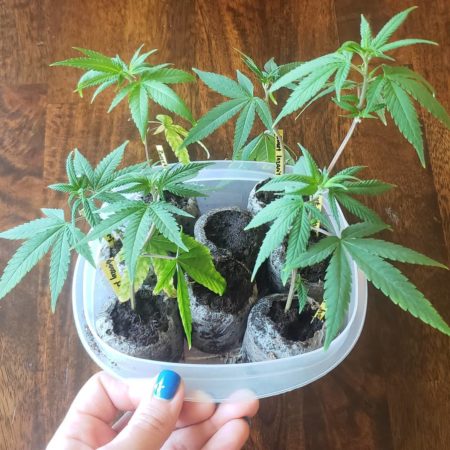
Learn how to clone cannabis in an aerocloner (aero cloner is a hydroponic system that speeds up root formation)
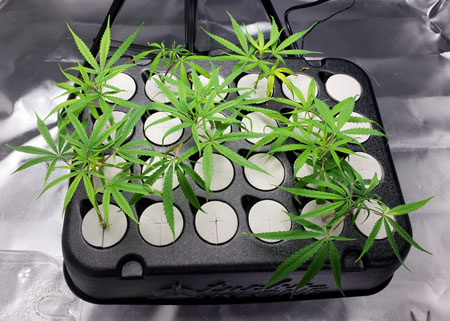
Why take 7-9″ (18-23 cm) tall cannabis clones?
You can take marijuana clones of almost any size, but this height tends to root quickly, and the resulting plants are typically a good size to start for most growers. This results in clones about the size of a 2-3 week old seedling.
This is what a 7″ clone looks like once it is rooted. An excellent size to start growing in most setups.
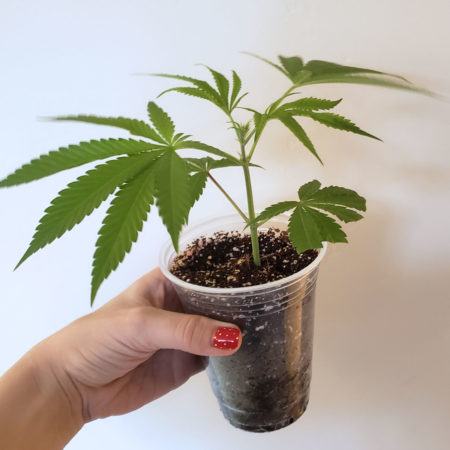
What about shorter or taller clones?
Small cannabis clones take a long time to make roots and are slow to grow, but you can make them. This clone was only a few inches tall, and its roots formed after almost 30 days.
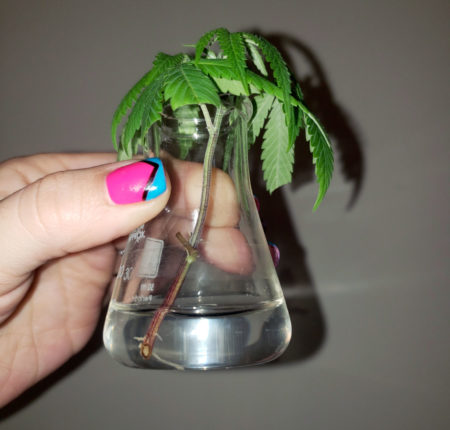
Although they can be cloned, small cuttings are generally more likely to wilt and take a long time to make roots.
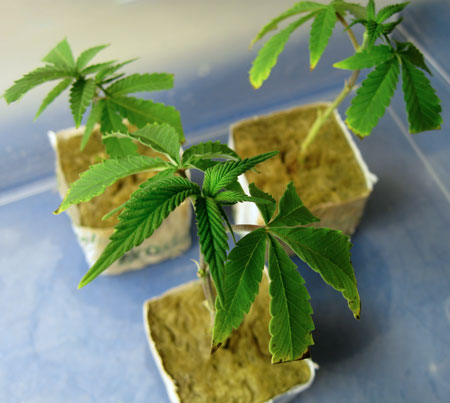
You can take big marijuana clones, too. I’ve seen growers take 12″ (30 cm) clones or even longer, especially when using an aerocloner, to cause roots to form. Big clones make roots in the right environment, and plants will already be well developed. If you’ve got long branches and want tall plants right away, you can turn those branches into big clones. However, more significant clones are likelier to wilt and die because they have difficulty getting water to their tallest leaves and branches. The other issue with big clones is they already have a set stem structure. With smaller clones, you can shape the size and shape of the clone via plant training, but with big clones, the structure is already set.
A big clone has a set stem structure because it is tall. This may or more not be good for you, depending on your desired size and shape.
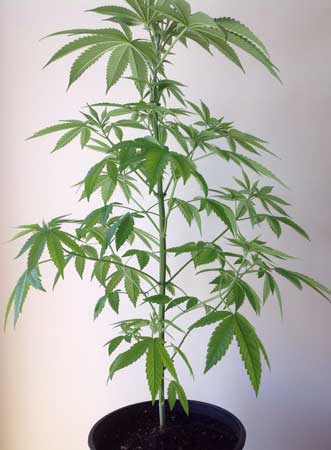
But how do you know which plants will be good when you clone them in the vegetative stage?
Best Way To Clone Cannabis
Aeroponic cloners make for very easy cloning, and by far the best way to create a large number of clones at one time.
The best way to clone cannabis is by taking cuttings from a healthy mother plant. Start by selecting a mature, disease-free plant with desirable traits. Use clean, sharp scissors to cut a 45-degree angle on a stem and remove lower leaves. Dip the cutting in a rooting hormone before placing it in a well-draining medium. Ensure proper humidity, lighting, and temperature for successful cloning.
Determine the Sex of a Cannabis Plant
This is where things get a little bit tricky…
There are two primary ways to identify male and female plants in the vegetative stage. Looking at pre-flowers or taking an early clone and flowering it.
Although you can identify the gender of a cannabis plant when it’s just 3-6 weeks old from seed, you may choose to clone your plant earlier and, therefore, won’t know the gender. To get around this, you can always take clones of all your plants before you put them into the flowering stage. This will give you a “copy” just in case any of your plants end up blowing you away with their quality.
Keep these clones in the vegetative stage and allow them to start growing. I have a vegetative tent and a flowering tent, and I stick new, healthy clones in the vegetative tent until I’m ready to flower them.
Continue to nurture these new clones and allow them to start growing into full-size plants. Meanwhile, as your primary garden starts flowering, the “parent” plants will reveal their actual characteristics.
At this point, throw away any clones from a male plant or plant that grows slowly. You’ll be glad you labeled them!
After harvest, you will know which plants had the best yields, growth, etc. Keep the clones you took from these best plant(s). These clones will become your “mother” plants from which you can take further clones whenever you need new babies.
How do you keep a mother plant from getting too big?
You can easily keep a mother plant in the vegetative stage for two years or more as long as you keep the plant under a vegetative light schedule. Any clones can be kept in the same place until you’re ready to move them into your main growing area. Please ensure the mother plant is well-fed and happy so that any clones you take off her are healthy and robust.
However, if you keep light and nutrient levels low, the plant will tend to grow slower, so you can keep the genetics without growing a huge plant. You can take clones off the top of the plant to help control height, and plant training can be used to train a plant to grow into almost any size and shape.
What is Cannabis Cloning?
Cannabis cloning is the process of creating a genetically identical copy of a parent plant. This is done by cutting a stem from the parent plant and rooting it in a growing medium to grow into a new, separate plant. Cloning cannabis plants allows growers to produce multiple identical plants with the same genetic traits and characteristics, such as flower structure and potency, as the parent plant.u003cbru003e- Cloning is a method to produce identical copies of a parent plant.u003cbru003e- The process involves cutting a stem and rooting it in a growing medium.u003cbru003e- Cloned plants have the same genetic traits as the parent plant.
Why Clone Cannabis Plants?
There are several reasons why growers choose to clone their cannabis plants, including:u003cbru003eConsistent and reliable outcomes:u003cbru003e- Cloning allows growers to reproduce plants with known and desirable traits, ensuring consistency and reliability in the final product.u003cbru003e- Speed up the growing process: Cloning can speed up the growing process by skipping the seedling stage and going straight to the vegetative stage.u003cbru003e- Preserve genetics: Cloning allows growers to preserve the genetics of a prized plant and multiply it, rather than having to purchase new seeds every time they want to grow a specific strain.u003cbru003e- Cloning provides consistent and reliable outcomes.u003cbru003e- Cloning can speed up the growing process.u003cbru003e- Cloning allows growers to preserve desirable genetics.
What are the Best Conditions for Cloning Cannabis?
The best conditions for cloning cannabis include:u003cbru003e- High humidity: Clones require a high level of humidity to prevent the cutting from drying out and to encourage root growth.u003cbru003e- Proper temperature: Clones should be kept at a temperature between 70-76°F to promote root growth and discourage mold or bacteria growth.u003cbru003e- Adequate light: Clones should receive indirect or fluorescent light for 18-24 hours a day to promote growth and health.u003cbru003e- High humidity is important for cloning cannabis.
Enjoy the power of marijuana cloning!
Cloning gives you the power to take one plant and get unlimited new cannabis plants practically forever! You can clone clones without a problem. Each new clone is a genetic copy of the original plant.

